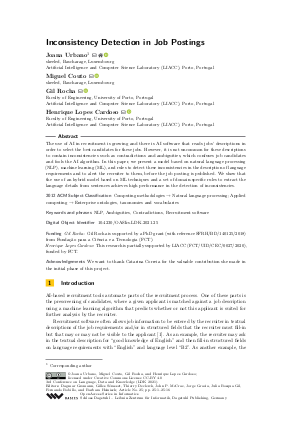OASIcs.LDK.2021.25.pdf
- Filesize: 0.57 MB
- 16 pages

 Creative Commons Attribution 4.0 International license
Creative Commons Attribution 4.0 International license

The use of AI in recruitment is growing and there is AI software that reads jobs' descriptions in order to select the best candidates for these jobs. However, it is not uncommon for these descriptions to contain inconsistencies such as contradictions and ambiguities, which confuses job candidates and fools the AI algorithm. In this paper, we present a model based on natural language processing (NLP), machine learning (ML), and rules to detect these inconsistencies in the description of language requirements and to alert the recruiter to them, before the job posting is published. We show that the use of an hybrid model based on ML techniques and a set of domain-specific rules to extract the language details from sentences achieves high performance in the detection of inconsistencies.





















Feedback for Dagstuhl Publishing